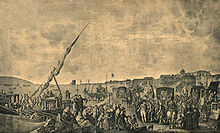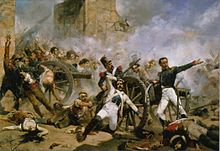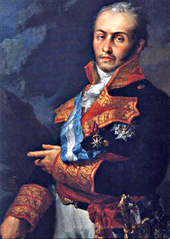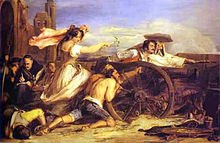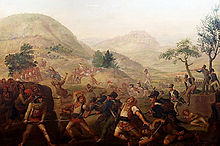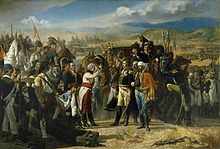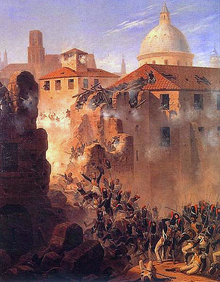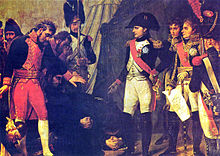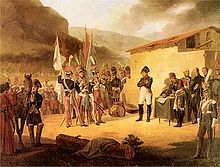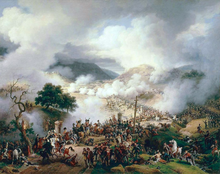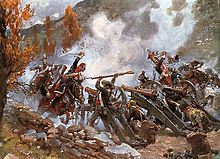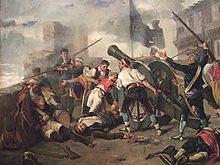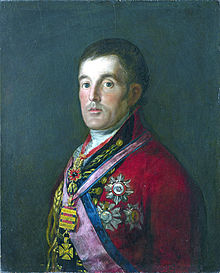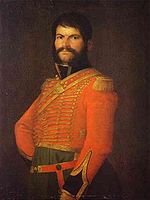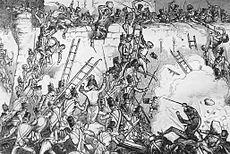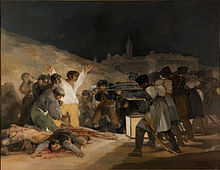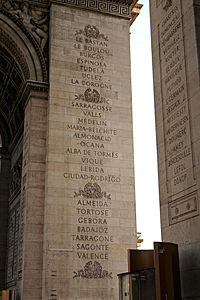- Peninsular War
-
Peninsular War Part of the Napoleonic Wars 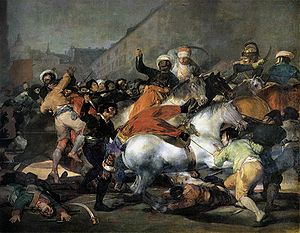
The Second of May, 1808: The Charge of the Mamelukes, by Francisco Goya (1814)Date 2 May 1808 (sometimes 27 October 1807[1]) — 17 April 1814[2] Location Iberian Peninsula, southern France Result Allied victory
Treaty of Valençay: restoration of Ferdinand VII;Belligerents  Spain
Spain
 Portugal
Portugal
 United Kingdom
United Kingdom French Empire
French Empire
 Kingdom of Spain (Napoleonic)
Kingdom of Spain (Napoleonic)Commanders and leaders  Arthur Wellesley
Arthur Wellesley
 William Beresford
William Beresford
 John Moore †
John Moore †
 Miguel Álava Esquivel
Miguel Álava Esquivel
 Joaquín Blake y Joyes
Joaquín Blake y Joyes
 Francisco Castaños
Francisco Castaños
 Juan Martín Díez
Juan Martín Díez
 José Palafox
José Palafox
 Gregorio de la Cuesta
Gregorio de la Cuesta
 Bernardino Freire †
Bernardino Freire †
 Miguel Pereira Forjaz
Miguel Pereira Forjaz
 Carlos Federico Lecor
Carlos Federico Lecor
 Joseph Bonaparte
Joseph Bonaparte
 Joachim Murat
Joachim Murat
 Jean-Andoche Junot
Jean-Andoche Junot
 Jean de Dieu Soult
Jean de Dieu Soult
 André Masséna
André Masséna
 Michel Ney
Michel Ney
 Louis Gabriel Suchet
Louis Gabriel Suchet
 Joseph Mortier
Joseph Mortier
 Auguste de Marmont
Auguste de Marmont
 Jean-Baptiste Bessières
Jean-Baptiste Bessières
 Jean-Baptiste Jourdan
Jean-Baptiste Jourdan
 Claude Victor-PerrinEnglish Wars (Gunboat War – Dano-Swedish War) – Anglo-Maratha War - Third Coalition – Anglo-Spanish War - Russo-Persian War - Pomeranian War – Fourth Coalition – Russo-Turkish War – Finnish War – Anglo-Turkish War – Peninsular War – Anglo-Russian War – Fifth Coalition – Anglo-Swedish War – French invasion of Russia – War of 1812 – Sixth Coalition (German Campaign) – Swedish-Norwegian War – Seventh Coalition
Claude Victor-PerrinEnglish Wars (Gunboat War – Dano-Swedish War) – Anglo-Maratha War - Third Coalition – Anglo-Spanish War - Russo-Persian War - Pomeranian War – Fourth Coalition – Russo-Turkish War – Finnish War – Anglo-Turkish War – Peninsular War – Anglo-Russian War – Fifth Coalition – Anglo-Swedish War – French invasion of Russia – War of 1812 – Sixth Coalition (German Campaign) – Swedish-Norwegian War – Seventh Coalition
The Peninsular War[3] was a war between France and the allied powers of Spain, the United Kingdom, and Portugal for control of the Iberian Peninsula during the Napoleonic Wars. The war began when French and Spanish armies crossed Spain and invaded Portugal in 1807. Then, in 1808, France turned on its ally, Spain. The war lasted until the Sixth Coalition defeated Napoleon in 1814.The conflict is regarded by some historians as one of the first national wars[4] and is also significant for the emergence of large-scale guerrilla warfare (guerrilla means "little war" in Spanish).[5] The French occupation destroyed the Spanish administration, which fragmented into quarrelling provincial juntas. In 1810, a reconstituted national government fortified itself in Cádiz and proved unable to recruit, train, or equip effective armies due to being under siege. British and Portuguese forces secured Portugal, using it as a secure position from which to launch campaigns against the French army while Spanish guerrilleros bled the occupiers.[6] Combined, the regular and irregular allied forces prevented Napoleon's marshals from subduing the rebellious Spanish provinces.[7] To the Spanish the war is known as the Guerra de la Independencia Española, or Spanish War of Independence, but this name is not often used in English, as Spain had been independent for a long time before the French invasion.
The many years of fighting in Spain gradually wore down France's famous Grande Armée. While the French armies were often victorious in battle, their communications and supplies were severely tested and their units frequently cut off, harassed, or overwhelmed by partisans. The Spanish army, though beaten and driven to the peripheries, could not be stamped out and continued to hound the French relentlessly.[8]
The constant threatening presence of a British force under Arthur Wellesley, which became the most experienced and steady force in the British army, guarded Portugal and campaigned against the French in Spain alongside the reformed Portuguese army. Allied to the British, the demoralized Portuguese army underwent extensive reorganizing, retraining and refitting under the command of British General William Carr Beresford,[9] appointed commander-in-chief of the Portuguese forces by the exiled Portuguese Royal family, and fought as part of a combined Anglo-Portuguese army under Wellington.
In 1812, as Napoleon embarked upon an invasion of Russia which ended in disaster, a combined allied army under Arthur Wellesley pushed into Spain and took Madrid. Marshal Soult led the exhausted and demoralized French forces in a fighting withdrawal across the Pyrenees and into France over the winter of 1813-14.
War and revolution against Napoleon's occupation led to the Spanish Constitution of 1812, later a cornerstone of European liberalism.[10] The burden of war destroyed the social and economic fabric of Portugal and Spain and ushered in an era of social turbulence, political instability and economic stagnation. Devastating civil wars between liberal and absolutist factions, led by officers trained in the Peninsular War, persisted in Iberia until 1850. The cumulative crises and disruptions of invasion, revolution and restoration led to the independence of many of Spain's American colonies and the independence of Brazil from Portugal.
Origins of the Peninsular War
In 1806, while in Berlin, Napoleon declared the Continental Blockade, forbidding British imports into continental Europe.[11] Of the two remaining neutral countries, Sweden and Portugal, the latter tried in vain to avoid Napoleon's ultimatum (since 1373, it had had a treaty of alliance with the English which became an alliance with the United Kingdom). After the Treaty of Tilsit in 1807, which cemented French dominance over Central and Eastern Europe, Napoleon decided to capture the Iberian ports.[12] The decision went against Napoleon's own advice earlier in his career, once remarking that a conquest of Spain would be "too hard a nut to crack"[13]
On 27 October 1807, Spain's Prime Minister Manuel de Godoy and France signed the Treaty of Fontainebleau, splitting Portugal into three kingdoms: the new Kingdom of Northern Lusitania, the Algarve (expanded to include Alentejo), and a rump Kingdom of Portugal.[14] In November 1807, after the refusal of Prince Regent John of Portugal to join the Continental System, Napoleon sent an army into Spain under General Jean-Andoche Junot with the task of invading Portugal. At the same time, General Dupont was sent in the direction of Cádiz and Marshal Soult towards Corunna.
Godoy initially requested Portugal's alliance against the incoming French armies, but later secretly agreed with France that, in return for Spain's cooperation, it would receive Portugal's territories. Spain's main ambition was the seizure of the Portuguese fleet, and it sent two divisions to help French troops occupy Portugal.
The Portuguese army was positioned to defend the ports and the coast from a French attack, and on 1 December Lisbon was captured with no military opposition. The escape on 29 November of Maria I of Portugal and Prince Regent John, together with the administration and the Court (around 10,000 people and 9,000 sailors aboard 23 Portuguese war ships and 31 merchant ships) was a major setback for Napoleon and enabled the Prince Regent to continue to rule over his overseas possessions, including Brazil. The Portuguese Royal Family established itself at Rio de Janeiro in Brazil for the next 13 years.
Iberian Insurrections
Under the pretext of reinforcing the Franco-Spanish army occupying Portugal, French Imperial troops began filing into Spain; the populace greeted them with enthusiasm in spite of growing diplomatic unease. In February 1808 Napoleon ordered the French commanders to seize key Spanish fortresses, and in doing so he had officially turned on his ally.[15] A French column, disguised as a convoy of wounded, took Barcelona on 29 February by persuading the authorities to open the city's gates.[16] Many commanders were not particularly concerned about the fate of the ruling regime, nor were they in any position to fight. (When Brigadier Alvarez garrisoned the Barcelona citadel against the French, his own superiors ordered him to stand down.)[citation needed]
The Spanish Royal Army of 100,000 men found itself paralysed: under-equipped,[17] frequently leaderless, confused by the turmoil in Madrid and scattered from Portugal to the Balearic Islands. Fifteen thousand of its finest troops, (General La Romana's Division of the North) had been lent to Napoleon in 1807 and remained stationed in Denmark under French command. Only the peripheries contained armies of any strength: Galicia, with Joaquin Blake's troops, and Andalusia, under Castaños. The French were consequently able to seize much of northeastern Spain by coups de main, and any hope of turning back the invasion was stillborn.
To secure his gains Napoleon pursued a series of intrigues against the Spanish royal family. A coup d'état instigated by the Spanish aristocrats forced Charles IV from his throne and replaced him with his son Ferdinand. Napoleon removed the royals to Bayonne and forced them both to abdicate on 5 May, handing the throne to his brother Joseph Bonaparte. A puppet Spanish council approved the new king, but the usurpation provoked a popular uprising that eventually spread throughout the country. The Spanish revolt was the first example of the nationalism of another country being turned against Napoleon, although it was led largely by priests and nobles who stood for the conservative values of the old regime. On 2 May, the citizens of Madrid rose up in rebellion against the French occupation, killing some 150 French soldiers, before the uprising was put down by Murat's elite guard and mameluk cavalry, which crashed into the city, trampling the rioters.[18]
The next day, immortalized by Goya in his painting, The Third of May 1808, the French army shot hundreds of Madrid citizens in retaliation. Similar reprisals were repeated in other cities and continued for days, with no military effect but to strengthen the resistance; soon afterward bloody, spontaneous fighting known as guerrilla ("little war") erupted in much of Spain; the term "guerrilla" has been used ever since to describe such combat.[19]
The tiny province of Asturias rose up in arms, cast out its French governor on 25 May and "declared war on Napoleon at the height of his greatness."[20] Within weeks, all the Spanish provinces had followed its example.[21] Mobs butchered 338 French citizens in Valencia. Every French ship of the line anchored at Cádiz was bombarded and captured.[22] Napoleon had unwittingly provoked a total war against the Spaniards, a mistake from which the French Empire would never truly recover.[23]
The deteriorating strategic situation forced France to increase its military commitments – in February, Napoleon had boasted that 12,000 men could conquer Spain;[24] by 1 June, over 65,000 troops were rushing into the country in an effort to control the crisis.[25] The main French army of 80,000 men held only a narrow strip of central Spain stretching from Pamplona and San Sebastián in the north through to Madrid and Toledo to the south. The French in Madrid took shelter behind an additional 30,000 troops under Moncey. Junot stood stranded in Portugal, cut off by 300 mi (480 km) of hostile territory.
From Murat's optimistic reports, Napoleon believed the uprisings would die down and the country settle into order if his brother held on to the throne in Madrid while French flying columns seized and pacified Spain's major cities. To this end, Gen. Dupont led 24,430 men south toward Seville and Cádiz; Marshal Bessières moved into Aragón and Old Castile with 25,000 men, aiming to capture Santander with one hand and Saragossa with the other; Gen. Moncey marched toward Valencia with 29,350 men; and Gen. Duhesme marshalled 12,710 troops in Catalonia and put Gerona under siege.[26] Historians have concluded that Napoleon, having no respect for the "insolent" Spanish militias which everywhere opposed him,[27] tried to do too much with too little.
The signs of trouble came quickly: Catalan militia (somatén) virtually overran Barcelona, and French units attempting to break the ring were turned back at the Bruc with heavy casualties. Gerona twice resisted all efforts to conquer it.[28] At Saragossa, French overtures for an honorable capitulation met with the laconic reply, "War to the knife."[29] Gen. Palafox and the Spaniards defied the French for three months, fighting inch by inch, corp à corp in the streets; finally they forced Lefebvre to lift the siege in August and limp away in defeat. Moncey's push toward the coast ended in defeat outside the walls of Valencia, where 1,000 French recruits fell trying to storm a city whipped into a frenzy by the clergy. Making short work of Spanish counterattacks, Moncey began a long retreat, harried at every step.[27] After storming and sacking Cordoba, Dupont, cowed by the mass hostility of the Andalusians, broke off his offensive and retired to Andujar.
Only in the north did the French find a measure of success. In June, Gen. Lasalle's cavalry trampled Gen. Cuesta's small, improvised army at Cabezón and unbarred the road to Valladolid. When Bessières' march on Santander was checked by a string of partisan attacks in July, the French turned back and found Blake and Cuesta with their combined army atop Medina del Rio Seco. The Spanish generals, at Cuesta's insistence, were making a dash toward the vulnerable French supply lines at Valladolid. The two armies deployed on 14 July, Cuesta unwisely leaving a gap between his troops and Blake's. The French poured into the hole and, after a sharp fight against Cuesta, swept the motley Spanish army from the field, putting Old Castile firmly back in Napoleon's hands.
Bessières' victory salvaged the strategic position of the French army in northern Spain. The road to Madrid lay open to Joseph, and the failures at Girona, Valencia and Saragossa were forgotten; all that remained was to reinforce Dupont and allow him to force his way south through Andalusia. A delighted Napoleon asserted that "if Marshal Bessières has been able to beat the Army of Galicia with few casualties and small effort, General Dupont will be able to overthrow everybody he meets."[30] Just a few days later, Dupont was sorely defeated at Bailén and surrendered his entire Army Corps to Gen. Castaños.
The catastrophe was total. With the loss of 24,000 troops, Napoleon's military machine in Spain abruptly collapsed. Joseph and the French command panicked and ordered a general retreat to the Ebro, abandoning Madrid and undoing all of Bessières' hard-fought gains. Europe cheered at this first check to the hitherto unbeatable Imperial armies – a Bonaparte had been chased from his throne; tales of Spanish heroism inspired Austria and showed the force of national resistance. Bailén set in motion the rise of the Fifth Coalition against Napoleon.[31]
Retreat from Portugal (August 1808)
Before the Peninsular War, British military operations on mainland Europe had been limited to raids after several early attempts to land and keep an army in action led to failure and ultimate withdrawal. The British could not field a large enough force to operate on its own against the huge and experienced French army. On 18 June, the Portuguese uprising broke out. The popular uprisings in Portugal and Spain encouraged the British to commit substantial forces once again and British propaganda was quick to capture the novelty of the situation; for the first time, peoples, not princes, were in rebellion against the "Great Disturber".
British Intervention
In August 1808, British forces (including the King's German Legion) landed in Portugal under the command of Lieutenant-General Sir Arthur Wellesley, the future Duke of Wellington. Wellesley checked Delaborde's forces at Roliça on 17 August, while the Portuguese Observation Army of Bernardino Freire contained Loison. On 20 August, the Anglo-Portuguese held their line at the Vimeiro and repulsed Junot. Wellesley, however, was considered too junior an officer to command the newly-reinforced expedition to Portugal and was replaced by Harry Burrard, who proceeded to grant Junot very favourable armistice terms, allowing for his unmolested evacuation from Portugal — courtesy of the Royal Navy — under the controversial Convention of Sintra in August. The British commanders were ordered back to England for an inquiry into Sintra, leaving Sir John Moore to head the 30,000-strong British force, supplied, convoyed, and protected by the Royal Navy.
Vice-Admiral Lord Collingwood's Mediterranean Fleet bottled up the remaining French fleet, stationed at Toulon since its defeat at Trafalgar. In June, General La Romana orchestrated a remarkable escape from Denmark, via Gothenburg, by slipping the better part of his Division of the North aboard a British squadron, which set sail for Santander.[24] The presence of the Royal Navy along the coast of France and Spain slowed the French entry into eastern and southern Spain and drained their military resources in the area. Frigates commanded the strategic Gulf of Roses north of Barcelona, close to the French border, and were conspicuously involved in the defence of Rosas; Lord Cochrane held a cliff-top fortress against the French for nearly a month, destroying it when the main citadel capitulated to a superior French force.[32]
Napoleon's campaign (October 1808 – January 1809)
Bailén and the loss of Portugal convinced Napoleon of the peril he faced in Spain. Deeply disturbed by news of Sintra, the Emperor remarked,
“ I see that everybody has lost their head since the infamous capitulation of Bailén. I realise that I must go there myself to get the machine working again.[33] ” The French, all but masters of Spain in June, stood with their backs to the Pyrenees, clutching at Navarre and Catalonia. It was not known if even these two footholds could be maintained in the face of a Spanish attack.
However, no attack was forthcoming. The Spanish social fabric, shaken by the shock of rebellion, gave way to its crippling social and political tensions; the patriots stood divided on every question and their nascent war effort suffered accordingly. With the fall of the monarchy, constitutional power devolved to local juntas. These institutions interfered with the army and the business of war, undermined the tentative central government taking shape in Madrid,[34] and in some cases proved almost as dangerous to each other as to the French.[35] The British army in Portugal, meanwhile, was itself immobilized by logistical problems and bogged down in administrative disputes, and did not budge.
Consequently, months of inaction passed at the front, the revolution having "temporarily crippled Patriot Spain at the very moment when decisive action could have changed the whole course of the war."[36] While the allies inched forward, a vast consolidation of bodies and bayonets from the far reaches of the French Empire brought 100,000 veterans of the Grande Armée into Spain, led in person by Napoleon and his Marshals.[37] With his Armée d'Espagne of 278,670 men drawn up on the Ebro, facing a scant 80,000 raw, disorganized Spanish troops, the Emperor announced to the Spanish deputies:[38]
“ I am here with the soldiers who conquered at Austerlitz, at Jena, at Eylau. Who can withstand them? Certainly not your wretched Spanish troops who do not know how to fight. I shall conquer Spain in two months and acquire the rights of a conqueror. ” Napoleon led the French on a brilliant[39] offensive involving a massive double envelopment of the Spanish lines. The attack began in November and has been described as "an avalanche of fire and steel."[40]
In the west, however, one Spanish wing slipped the noose when Marshal Lefebvre failed to encircle the Army of Galicia after a premature and indecisive attack at Pancorbo; General Blake drew his artillery back to safety and the bloodied Spanish infantry followed in good order. Lefebvre and Victor offered a careless chase that ended in humiliation at Valmaseda where their scattered troops were roughly handled by La Romana's newly repatriated Spanish veterans and narrowly escaped to safety.
The campaign raced to a swift conclusion in the south, where Napoleon's main army overran the unprotected Spanish centre in a devastating attack near Burgos. The Spanish militias, untrained and unable to form infantry squares, scattered in the face of massed French cavalry, while the Spanish and Walloon Guards stood their ground in vain and were chewed up by Lasalle and his sabreurs. Marshal Lannes with a powerful force then smashed through the tottering Spanish right wing at Tudela on 23 November, routing Castaños and adding a new inscription to the Arc de Triomphe in Paris.
Finally, Blake's isolated army about-faced on 17 November and dug in at Espinosa. His lines shook off French attacks over a day and night of vicious fighting before cracking the next day. Blake again outmarched Soult and escaped with a rump army to Santander, but the Spanish front had been torn apart and the Imperial armies raced forward over undefended provinces. Napoleon flung 45,000 men south into the Sierra de Guadarrama which shielded Madrid.
The mountains hardly slowed Napoleon at all: at Somosierra pass on 30 November, his Polish and Guard cavalry squadrons charged up a narrow gorge through raking fire to overrun General San Juan's artillery. San Juan's militias then gave way before the relentless French infantry, while the Spanish royal artillerymen stuck to their guns and fought to the last. French patrols reached Madrid on 1 December and entered the city in triumph on 4 December. Joseph Bonaparte was restored to his throne. San Juan retreated west to Talavera, where his mutinous conscripts shot him before dispersing.
General Sir John Moore's small British army moved from Portugal into northwestern Spain, surprising a body of French cavalry at Sahagun. Moore remained in Leon for some time after he recognised that the position of his army was perilous; this was a calculated attempt to draw the attention of the French and give the Spanish forces time to rally after their recent reverses. In this Moore was successful, alerted to his whereabouts the Imperial army forced Moore into a harrowing retreat marked by a breakdown in the discipline of many regiments. The retreat was punctuated by stubborn rearguard actions at Benavente and Cacabelos, each time the British army turned to fight the discipline of the troops showed a marked, but temporary, improvement. La Romana dutifully marched his tattered army to cover his ally's retreat, but while the British troops managed to escape to the sea at A Coruña after fending off a strong French attack, the Spaniard had no escape and was defeated by Soult at Mansilla. Some 26,000 sickly troops eventually reached Britain, 7,000 men having been lost over the course of the expedition.[41] Moore, killed while directing the defence of Coruña, remains buried in Spain under a monument constructed by Soult.
In Catalonia, Napoleon fed his faltering army strong reinforcements as early as October 1808, ordering Marshal St. Cyr with 17,000 men to the relief of Duhesme in Barcelona. Rosas fell to the French at the end of November, opening the path south for St. Cyr, who bypassed Girona and, after a remarkable forced march, fell upon and destroyed part of the Spanish army at Cardedeu, near Barcelona (18 December). St. Cyr and Duhesme chased the retreating Spaniards under General Reding, capturing 1,200 men at Molins de Rey. In February 1809, Reding led a reconstituted army against the French right wing and, after vigorous marching and countermarching, took a stand at Valls only to be ridden down and killed by French cavalry.
Only at Saragossa, still scarred from Lefebvre's bombardments that summer, was the Imperial charge temporarily halted once again. The French invested the city on 20 December. Lannes and Moncey committed two army corps (45,000 men) and considerable materiel to a second siege of the city, but their numbers and guns made no impression on the Spanish citizen-soldiers who, behind the walls of Saragossa, proved unmovable.
Palafox's second epic defence brought the city enduring national and international fame.[42][43] The Spaniards fought with a determination which never faltered; street by street, building by building, through pestilence and starvation; at times entrenching themselves in convents, at others putting their own homes to the torch. Nearly all who stood with Palafox met their deaths,[44] but for two months, the Grande Armée did not set foot beyond the Ebro's shore. On 20 February 1809, the French left behind burnt-out ruins filled with 64,000 corpses.[45][46] After only a little more than two months in Spain, Napoleon returned command to his marshals and went back to France.
Portuguese frontier (1809)
In March, Marshal Soult initiated the second invasion of Portugal through the northern corridor. Initially repulsed in the Minho river by Portuguese militias, he then captured Chaves, Braga and, on 29 March 1809, Porto. However, the resistance of Silveira in Amarante and other northern cities isolated Soult in Porto. William Carr Beresford, in his capacity as commander-in-chief (he had been appointed by the Portuguese Royal family), reorganised, rebuilt and refitted the Portuguese army with the aid of senior Portuguese generals, in particular Miguel Pereira Forjaz. In a first phase, some 20,000 were called to the regular army and 30,000 to militias.[47] Wellesley returned to Portugal in April 1809 to command the Anglo-Portuguese forces. He strengthened the British army with the recently formed Portuguese regiments trained by General Beresford and adapted to the British way of campaigning. These new forces turned Soult out of Portugal at the Battle of Grijó (10–11 May) and the Second Battle of Porto (12 May). All other northern cities were recaptured by General Silveira.
With Portugal secured, Wellesley advanced into Spain to unite with General Cuesta's forces. The combined allied force prepared for an assault on Victor's I Corps at Talavera, 23 July. Cuesta, however, was reluctant to agree, and was only persuaded to advance on the following day.[48] The delay allowed the French to withdraw, but Cuesta sent his army headlong after Victor, and found himself faced by almost the entire French army in New Castile — Victor had been reinforced by the Toledo and Madrid garrisons. The Spanish retreated precipitously, necessitating two British divisions advancing to cover their retreat.[49]
The next day, 27 July, at the Battle of Talavera the French advanced in three columns and were repulsed several times throughout the day by Wellesley, but at a heavy cost to the British force. In the aftermath Marshal Soult's army was discovered to be advancing south, threatening to cut Wellesley off from Portugal. Wellesley moved east on 3 August to block it, leaving 1,500 wounded in the care of the Spanish, intending to confront Soult before finding out that the French were in fact 30,000 strong. The British commander sent the Light Brigade on a dash to hold the bridge over the Tagus River at Almaraz. With communications and supply from Lisbon secured for now, Wellesley considered joining with Cuesta again but found out that his Spanish ally had abandoned the British wounded to the French and was thoroughly uncooperative, promising and then refusing to supply the British forces, aggravating Wellesley and causing considerable friction between the British and their Spanish allies. The lack of supplies, coupled with the threat of French reinforcement (including the possible inclusion of Napoleon himself) in the spring, led to the British deciding to retreat into Portugal.
Bonaparte Kingdom of Spain
Amongst the liberal, republican and radical segments of the Spanish and Portuguese populations, there was much support for a potential French invasion, despite Napoleon having by 1807 noticeably and explicitly abandoned many liberal and republican ideals. Even before the invasion, the term "Afrancesado", literally "turned French" was used to denote those who supported the Enlightenment and secular ideals and the French Revolution.[50] Napoleon was to rely on the support of these "Afrancesados" both in the conduct of the war and administration of the country. But while Napoleon - through his brother Joseph who he installed as King - made good on his promises to "sweep away" all feudal and clerical privileges, soon most Spanish liberals came to oppose the occupation for the violence and brutality it brought.[51]
Emergence of Guerrilla War
The Spanish War of Independence was one of the most successful partisan wars in history and is the origin of the word guerrilla in the English language (from Spanish Guerra de guerrillas or "War of little wars"). However, this guerrilla warfare was costly to both sides. Not only did the 'patriotic' Spaniards trouble the French troops, they also petrified their countrymen with a combination of forced conscription and looting of towns. Many of the partisans were, in fact, either fleeing the law or trying to get rich, although later in the war the authorities tried to make the guerrillas militarily reliable, and many of them formed regular army units, like Espoz y Mina's "Cazadores de Navarra", among others.
The idea of forming the guerrillas into an armed force had positive and negative effects. On the one hand, uniform and stronger military discipline would stop men from running off into the streets and disappearing from the band. However, the more disciplined the unit was, the easier it was for the French troops to catch them when they sprang an ambush. Only a few partisan leaders formed up with the authorities; most did so just to lay off criminal charges and to retain the effective status of an officer in the Spanish army, so their weaponry, clothes and food would be paid for.
The guerrilla style of fighting was the Spanish military's single most effective application. Most organized attempts on the part of regular Spanish forces to take on the French led to their defeat. However, once the battle was lost and the soldiers reverted to their guerrilla roles, they effectively tied down greater numbers of French troops over a wider area with much less expenditure of men, energy, and supplies. Wellington's final success in the Peninsula is often said to be largely due to the collapse and demoralization of the French military structure in Spain caused by the guerrillas;
It was these obscure triumphs—a platoon shot down in an ambush, a courier and his message captured as he galloped across the plain—which made possible the orthodox victories of Wellington and his Anglo-Portuguese army and eventually the liberation of Portugal and Spain.[52]
Mass resistance by the people of Spain prefigured the total wars of the 20th century and eventually inspired parallel struggles by the Russians and Prussians. Tsar Alexander, when threatened with war, rebuked the French ambassador:
“ If the Emperor Napoleon decides to make war, it is possible, even probable, that we shall be defeated ... But ... the Spaniards have frequently been defeated; and they are not beaten, nor have they surrendered.[53] ” Defence of Portugal
Fearing a new French assault on Portugal, Wellesley[54] brought into action his plan to create a powerful defensive position near the Portuguese capital, to which he could fall back if necessary. To protect Lisbon he ordered the construction of the Lines of Torres Vedras under the supervision of Sir Richard Fletcher comprising three strong lines of forts, blockhouses, redoubts and ravelins with numerous fortified artillery positions. The various parts of the lines communicated to each other by semaphore, allowing immediate reaction to a threat. The work began in the autumn of 1809 and the first line was finished one year later. The areas immediately in front of the lines were subjected to a scorched earth policy in which they were denuded of food, forage and shelter to further hamper the enemy. Some 200,000 inhabitants of the neighbouring districts were relocated inside the lines.
Stalemate on the Portuguese Frontier
Taking the Spanish fortified town of Ciudad Rodrigo after a siege lasting from 26 April-9 July 1810, the French duly reinvaded Portugal in July with an army of around 65,000 led by Marshal Masséna. The first significant clash on Portuguese soil was at the Battle of Coa with the French driving back the Robert Crauford's heavily outnumbered Light Division. Masséna now moved to attack the strongly held British position on the heights of Bussaco (a 10-mile long ridge), resulting in the Battle of Buçaco on 27 September. Suffering high casualties, the French failed to dislodge the Anglo-Portuguese army. Masséna now maneuvered to flank the position, at which point Wellesley fell back to the fortified Lines of Torres Vedras.
The fortifications were so impressive that, after an attack by a small force at Sobral on 14 October, a stalemate ensued. As Charles Oman wrote, "On that misty 14 Octoberth morning, at Sobral, the Napoleonic tide attained its highest watermark, then it ebbed." The frontal zones of the lines having been subjected to a scorched earth policy, the French were eventually forced to withdraw due to sickness and lack of food and supplies. The British suffered a setback just the next day in the Battle of Fuengirola. On 15 October, a much smaller Polish garrison held off British troops under Lord Blayney, who was subsequently taken captive and held by the French until 1814. Amazingly the French intelligence never knew that the fortifications were being built, only when their scouts reached the walls did they know. It’s also rumoured that even the British government never knew about it as well because all the funds that were used to build it was paid for by the Portuguese government and captured French equipment and supplies.
The allies were reinforced by the arrival of fresh British troops in early 1811 and began an offensive. A French force was beaten at Barrosa on 5 March as part of an unsuccessful manoeuvre to break up the siege of Cádiz, and Masséna was forced to withdraw from Portugal after an allied victory at the Battle of Fuentes de Onoro (3–5 May). Masséna had lost 25,000 men in the fighting in Portugal and was replaced by Auguste Marmont. Soult came from the South to threaten Extremadura, and captured the fortress town of Badajoz before returning to Andalusia with most of his army. An Anglo-Portuguese and Spanish army led by the British Marshal William Beresford marched to try and retake the town; they laid siege to the French garrison Soult had left behind, but Soult regathered his army and marched to relieve the siege. Beresford moved his besieging army from Badajoz to intercept the marching French, and after the Battle of Albuera on 16 May, Soult was forced to retreat to Seville.
The war now fell into a temporary lull, the numerically superior French being unable to find an advantage and coming under increasing pressure from Spanish guerrilla activity. The French had upwards of 350,000 soldiers in L'Armée de l'Espagne, but the vast majority, over 200,000, was deployed to protect the French lines of supply, rather than as substantial fighting units. Meanwhile, the Spaniards drafted the liberal Spanish Constitution of 1812.
British-Portuguese Offensive of 1812
“ The emperor wants me to take the offensive...but his Majesty does not realize that the smallest movement in these parts expends great quantities of resources, especially of horses... To make a requisition on even the poorest village we have to send a detachment of 200 men and, to be able to live, we have to scatter over great distances. ” —Marshal August Marmont[55]
In January 1812, Napoleon approved the full annexation of Catalonia into the French Empire. Its territory was divided in départements (Ter, Sègre, Montserrat and Bouches-de-l'Èbre). Looking for the approval of the local population, Catalan was declared the official language in those departments together with French. However, the historical aversion that the Catalans had against the French insured that guerrilla activity continued in Catalonia.
Wellington renewed the allied advance into Spain just after New Year in 1812, besieging and capturing the fortified towns of Ciudad Rodrigo on 19 January and Badajoz, after a costly assault, on 6 April. The allied army took Salamanca on 17 June, just as Marmont approached — the two forces finally met on 22 July where Wellington inflicted a severe defeat on the French in the Battle of Salamanca, during which Marshal Marmont himself was severely wounded. As the French regrouped, the Anglo-Portuguese entered Madrid on 6 August and advanced towards Burgos, before retreating all the way back to Portugal when renewed French concentrations threatened to trap them. As a consequence of the Salamanca campaign the French were forced to end their long siege of Cadiz[56] and to permanently evacuate the provinces of Andalusia and Asturias.
Allied victory (1813–1814)
French hopes of recovery were stricken by Napoleon's disastrous invasion of Russia in 1812. He had taken 30,000 soldiers from the hard-pressed Armée de l'Espagne, and, starved of reinforcements and replacements, the French position became increasingly unsustainable as the allies renewed the offensive in May 1813.
In a strategic move, Wellington planned to move his supply base from Lisbon to Santander. The Anglo-Portuguese forces swept northwards in late May and seized Burgos; they then outflanked the French army, forcing Joseph Bonaparte into the valley of the River Zadorra. At the Battle of Vitoria, on 21 June, the 65,000 men of Joseph Bonaparte's army were routed by 53,000 British, 27,000 Portuguese and 19,000 Spaniards. Wellesley pursued and dislodged the French from San Sebastián, which was sacked and burnt to the ground by the Anglo-Portuguese.
The allies chased the retreating French, reaching the Pyrenees in early July. Soult was given command of the French forces and began a counter-offensive, dealing the allied generals two sharp defeats at the Battle of Maya and the Battle of Roncesvalles. Yet he was severely repulsed by the Anglo-Portuguese, lost momentum, and finally fled after the allied victory at the Battle of Sorauren (28 July and 30 July).
On 7 October, after Wellington received news of the reopening of hostilities in Germany, the allies finally crossed into France, fording the Bidasoa river. On 11 December, a beleaguered and desperate Napoleon agreed to a separate peace with Spain under the Treaty of Valençay, under which he would release and recognize Ferdinand in exchange for a complete cessation of hostilities. But the Spanish had no intention of trusting Napoleon, and the fighting continued.
The Peninsular War went on through the allied victories of Bera pass, the Battle of Nivelle, and the Battle of Nive near Bayonne (10–14 December 1813), the Battle of Orthez (27 February 1814) and the Battle of Bayonne (14 April), the latter occurring after Napoleon's abdication.
Role of intelligence
Intelligence played a crucial role in the successful prosecution of the war by the British after 1810. Spanish and Portuguese guerrillas were asked to capture messages from French couriers. From 1811 onwards, these dispatches were often either partially or wholly enciphered.
George Scovell of Wellington's General Staff was given the job of deciphering them. At first, the ciphers used were fairly simple and he received help from other members of the General Staff. However, beginning in 1812, a much stronger cipher, originally devised for diplomatic messages, came into use and Scovell was left to work on this himself. He steadily broke it, and the knowledge of French troop movements and deployments was used to great effect in most of the engagements described above. The French never realised that the code had been broken and continued to use it until their code tables were captured at the Battle of Vitoria.
Peace and Thereafter
Spain
King Joseph was cheered initially by Spanish afrancesados ("Frenchified"), who believed that collaboration with France would bring modernisation and liberty. An example was the abolition of the Spanish Inquisition. However, priesthood and patriots stirred up agitation among the populace, which became widespread after the French army's first examples of repression (Madrid, 1808) were presented as fact to unite and enrage the people. The remaining afrancesados were exiled to France following the departure of French troops.
The pro-independence side included both traditionalists and liberals. After the war, they would clash in the Carlist Wars, as new king Ferdinand VII, "the Desired One" (later "the Traitor king"), revoked all the changes made by the independent Cortes, which were summoned in Cádiz acting on his behalf to coordinate the provincial Juntas and resist the French. He restored absolute monarchy, prosecuted and put to death everyone suspected of liberalism, and altered the laws of royal succession in favour of his daughter Isabella II, thus starting a century of civil wars against the supporters of the former legal heir to the throne.
The liberal Cortes had approved the first Spanish Constitution on 19 March 1812, which was later nullified by the king. In Spanish America, the Spanish and Criollo officials formed Juntas that swore allegiance to King Ferdinand. This experience of self-government led the later Libertadores (Liberators) to promote the independence of the Spanish–American colonies.
French troops seized many of the extensive properties of the Catholic Church. Churches and convents were used as stables and barracks, and artworks were sent to France, leading to an impoverished Spanish cultural heritage. Allied armies also plundered Spanish towns and the countryside. These pieces can be viewed at the Duke's London home, Apsley House, and at his country estate, Stratfield Saye House.
Another notable effect of the war was the severe damage incurred by Spain's economy; devastated by the war, it continued to suffer in the political turbulence that followed.[57]
Portugal
The Peninsular War signified the traumatic entry of Portugal into the modern age. The Portuguese Court's transfer to Rio de Janeiro initiated the process of Brazil's state-building that eventually produced its independence in 1822. The skillful evacuation by the Portuguese Navy of more than 15,000 people from the Court, Administration, and Army was a bonus for Brazil and a blessing in disguise for Portugal, as it liberated the energies of the country. The Governors of Portugal nominated by the absent king had a scant impact because of the successive French invasions and British occupation.
The role of the War Minister Miguel Pereira Forjaz was unique. Wellington held him as the ablest man in Portugal.[58] Under Marshall Beresford he helped to build a regular army of 55,000 men and a further 50,000 as national guard milicias and a variable number of home guard ordenanças, perhaps totalling more than 100,000. In an 1812 letter to Baron Stein, the Russian Court Minister, Forjaz recommended a "scorched earth" policy and the trading of space for time as the only way to defeat a French invasion. Alexander I, Tsar of Russia, ordered his generals to use Wellington's Portuguese strategy and avoid battles to starve Napoleon's Grande Armée.[citation needed]
The nation at arms had a similar impact on Portugal as the French Revolution on France. A new class, tried, disciplined, and experienced by war against the French Empire, would assert Portuguese independence. Marshal Beresford and 160 officers were retained after 1814 to lead Portugal's Army while the King was still in Brazil. Portuguese politics hinged on the project of a Luso-Brazilian United Kingdom, with the African colonies supplying slaves, Brazil manufacturing and Portugal the trade. By 1820, this became untenable: Portuguese Peninsular War officers arranged the expelling of the British and began the liberal revolution at Porto on 24 August. Liberal institutions were only consolidated after a civil war in 1832–34.
Cultural
Goya's series of 82 prints The Disasters of War (1810–20) remains the most famous and powerful depiction of the war and its effects on the civilian population. The Manuscript Found in Saragossa by Jan Potocki (1814) is narrated from the time of the Peninsular War. Prosper Mérimée's Carmen (1845), on which Bizet's opera (1875) was based, is set during the war. The Spanish zarzuela, La Viejecita (1897) set in 1812, celebrates the entry of the joint forces into Madrid. The C. S. Forester novel Death to the French (1932) concerns a private in a British Rifle Regiment who is cut off from his unit and joins a group of Portuguese guerrillas. The 1957 motion picture The Pride and the Passion, also set during the war, was based on Forester's The Gun (1933). F. L. Lucas's novel The English Agent - A Tale of the Peninsular War (1969), about the Battle of Bailén and its aftermath, is the account of a British Army officer who, gathering information before the first British landings, buys a Frenchwoman at auction to save her from the Spanish mob. Lucas's poem "Spain 1809" (in From Many Times and Lands, 1953), the story of a Spanish village woman's courage during the French occupation, was turned into the play A Kind of Justice by Margaret Wood (1966). Curro Jiménez was a successful Spanish TV series (1976–79) about a generous bandit fighting against the French in the Sierra Morena. The Sharpe novels (1981–2007) by Bernard Cornwell were a series likewise following the adventures of a British Army officer and set, partly, during the Peninsular War. They were later made into a series of television movies featuring actor Sean Bean as Sharpe (see Sharpe (TV Series)). A short but dramatic episode from the war is given in Gary Jennings's Aztec Rage. A board wargame called Wellington — The Peninsular War 1812–1814 was produced by GMT Games in 2005.[59]
The Peninsular War saw the first use of medal bars. Also known as "devices", these are clasps affixed to the ribbons from which medals are suspended. The Peninsular Medal, more properly known as the Army Gold Medal, was issued to senior officers in Wellington's army. Clasps were added, each giving the name of a major battle in which the holder participated. When four clasps were earned a Peninsular Cross was awarded. Each arm was inscribed with one of the battles named on an earned clasp. Subsequent clasps were then added to the ribbon. Wellington's Peninsular Cross, featuring a unique nine clasps (thirteen battles), can be seen on his uniform in the basement of Apsley House. In 1847, the surviving lower ranked officers and enlisted men received the Military General Service Medal, with battle clasps, for service in this conflict.
See also
Notes
- ^ Glover, p. 45. Some accounts mark the Franco-Spanish invasion of Portugal as the beginning of the war.
- ^ Glover, p 335. Denotes the date of the general armistice between France and the Sixth Coalition.
- ^ Nicknamed the Spanish Ulcer, and also known in French as Guerre d'Espagne et du Portugal (War in Spain and in Portugal), or otherwise Spanish War of Independence — Guerra de la Independencia Española in Spanish. It is also known as Guerra del Francès ("the War of the Frenchman") in Catalonia and Invasões Francesas ("French Invasions") in Portugal.
- ^ Churchill, p. 258. "Nothing like this universal uprising of a numerous, ancient race and nation, all animated by one thought, had been seen before...For the first time the forces unchained by the French Revolution, which Napoleon had disciplined and directed, met not kings or Old World hierarchies, but a whole population inspired by the religion and patriotism which...Spain was to teach to Europe."
- ^ Laqueur, p. 350. Laqueur notes that the war was "one of the first occasions when guerrilla warfare had been waged on a large scale in modern times."
- ^ Gates, pp. 33–34. Gates notes that much of the French army "was rendered unavailable for operations against Wellington because innumerable Spanish contingents kept materialising all over the country. In 1810, for example, when Massena invaded Portugal, the Imperial forces in the Peninsula totaled a massive 325,000 men, but only about one quarter of these could be spared for the offensive—the rest were required to contain the Spanish insurgents and regulars. This was the greatest single contribution that the Spaniards were to make and, without it, Wellington could not have maintained himself on the continent for long—let alone emerge victorious from the conflict."
- ^ Chandler, The Art of Warfare on Land, p. 164
- ^ Glover, p. 52. Glover notes that "the Spanish troops were no match for the French. They were ill-equipped and sketchily supplied. Their ranks were filled with untrained recruits. Their generals bickered among themselves. They lost heavily but their armies were not destroyed. Time and time again Spanish armies lost their artillery, their colours, their baggage. They suffered casualties on a scale that would have crippled a French or a British army. They never disintegrated. They would retire to some inaccessible fastness, reorganise themselves and reappear to plague the French as they had never been plagued before."
- ^ Fletcher, Ian (2003) The Lines of Torres Vedras 1809-11, Osprey Publishing
- ^ Payne, Stanley G. (1973), A History of Spain and Portugal: Eighteenth Century to Franco, 2, Madison: University of Wisconsin Press, pp. 432–433, ISBN 9780299062705, http://libro.uca.edu/payne2/spainport2.htm, "The Spanish pattern of conspiracy and revolt by liberal army officers ... was emulated in both Portugal and Italy. In the wake of Riego's successful rebellion, the first and only pronunciamiento in Italian history was carried out by liberal officers in the kingdom of the Two Sicilies. The Spanish-style military conspiracy also helped to inspire the beginning of the Russian revolutionary movement with the revolt of the Decembrist army officers in 1825. Italian liberalism in 1820–1821 relied on junior officers and the provincial middle classes, essentially the same social base as in Spain. It even used a Hispanized political vocabulary, for it was led by giunte (juntas), appointed local capi politici (jefes políticos), used the terms of liberali and servili (emulating the Spanish word serviles applied to supporters of absolutism), and in the end talked of resisting by means of a guerrilla. For both Portuguese and Italian liberals of these years, the Spanish constitution of 1812 remained the standard document of reference."
- ^ Esdaile, p. 2
- ^ Gates, pp. 5–7 and Esdaile, pp. 2–5
- ^ McLynn, Frank. "Napoleon: A biography", Pimlico, London, 1997. (p. 396)
- ^ Esdaile, pp. 7–8 and Gates, p. 8
- ^ Esdaille, p. 166
- ^ Chandler, p. 605
- ^ Gates, p. 35. For example, the Army's 26 cavalry regiments of 15,000 men possessed only 9,000 horses.
- ^ Chandler, p. 610
- ^ Esdaile, pp. 302–303. Rebel groups sprung up on a local basis and were unaware of the resistance being prepared elsewhere in Spain. Esdaile asserts that the partisans were as committed to driving the ancien regime out of Spain as they were to fighting foreign armies, noting that the Patriots had no scruples about liquidating officials skeptical of their revolutionary program.
- ^ Churchill, p. 259
- ^ Gates, p. 12
- ^ Glover, p. 53
- ^ Chandler, p. 608. Chandler notes that Napoleon "never appreciated how independent the Spanish people were of their government; he misjudged the extent of their pride, of the tenacity of their religious faith and of their loyalty to Ferdinand. He anticipated that they would accept the change of regime without demur; instead he soon found himself with a war of truly national proportions on his hands."
- ^ a b Chandler, p. 611
- ^ Gates, p. 162
- ^ Chandler, p. 611. Gates, pp. 181–182
- ^ a b Chandler, p. 614
- ^ Gates, p. 61
- ^ Gates, p. 77
- ^ Chandler, p. 616
- ^ Chandler, p. 617. "This was an historic occasion; news of it spread like wildfire throughout Spain and then all Europe. It was the first time since 1801 that a sizable French force had laid down its arms, and the legend of French invincibility underwent a severe shaking. Everywhere anti-French elements drew fresh inspiration from the tidings. The Pope published an open denunciation of Napoleon; Prussian patriots were heartened; and, most significantly of all, the Austrian war party began to secure the support of the Emperor Francis for a renewed challenge to the French Empire.
- ^ James, pp. 131–132
- ^ Chandler, p. 620
- ^ Chandler, p. 625. Chandler notes that "the particular interests of the provincial delegates made even the pretense of centralised government a travesty."
- ^ Chandler, p. 621. John Lawrence Tone has questioned this assessment of the Spanish juntas on the grounds that it relies too much on the accounts of British officers and elites; these sources being patently unfair to the revolutionaries, "whom they despised for being Jacobins, Catholics, and Spaniards, not necessarily in that order."
- ^ Esdaille, pp. 304–305. Esdaille notes that the Junta of Seville declared itself the supreme government of Spain and tried to annex neighbouring juntas by force.
- ^ Gates, p. 487
- ^ Glover, p. 55
- ^ Chandler, p. 631
- ^ Churchill, p. 262
- ^ Gates, p. 114
- ^ Glover, p. 89
- ^ Gates, p. 128. Gates notes that the siege "was a demonstration the French army was never to forget and ... it was to inspire Spaniards to maintain replica struggles that have few parallels in the history of war.
- ^ Gates, p. 127. The military garrison of 44,000 left 8,000 survivors, 1,500 of them ill.
- ^ Glover, p. 89. 10,000 of these were French.
- ^ David A. Bell, Napoleon's Total War, TheHistoryNet.com
- ^ Later on, this number would grow to 50,000 in the army and another 50,000 in militias, in addition to 120,000 ordenanças and volunteer units.
- ^ Gates, p. 177
- ^ P. Guedalla, p. 186
- ^ McLynn, Frank. "Napoleon: A biography", Pimlico, London, 1997. (pp. 396-406)
- ^ McLynn, Frank. "Napoleon: A biography", Pimlico, London, 1997. (p406)
- ^ Glover, p. 10
- ^ Chandler, p. 746
- ^ The Lines of Torres Vedras: The Cornerstone of Wellington's Strategy in the Peninsular War 1809-1812, John Grehan, Spellmount
- ^ Grant, p. 209
- ^ "The Spanish Ulcer: Napoleon, Britain, and the Siege of Cádiz". Humanities, January/February 2010, Volume 31/Number 1. http://www.neh.gov/news/humanities/2010-01/Napoleon.html. Retrieved 2010-07-05.
- ^ Esdaile, pp. 505–507
- ^ Oman (1908), Vol. III, p. 418
- ^ GMT Games — Wellington
References
- Chandler, David G. (1995), The Campaigns of Napoleon, Simon & Schuster, ISBN 0025236601
- Esdaile, Charles (2002), The Peninsular War, Penguin Books (published 2003), ISBN 0140273700
- Gates, David (1986), The Spanish Ulcer: A History of the Peninsular War, Pimlico (published 2002), ISBN 0712697306
- Glover, Michael (1974), The Peninsular War 1807–1814: A Concise Military History, Penguin Classic Military History (published 2001), ISBN 0141390417
- Grant, Reg (2005), Battle: A Visual Journey Through 5,000 Years of Combat, Dorling Kindersley, ISBN 0-756-61360-4
- Guedalla, Philip (2005), The Duke, Hodder & Stoughton (published 1931), ISBN 0-340-17817-5
- James, William (1826), The Naval History of Great Britain, V, Harding, Lepard and Co, http://books.google.com/?id=Am7WCEX4KekC&pg=PA132&lpg=PA132&dq=cochrane+rosas, retrieved 2008-01-11
- Laqueur, Walter (July 1975), "The Origins of Guerrilla Doctrine", Journal of Contemporary History (Society for Military History) 10 (3): 341–382, doi:10.1177/002200947501000301.
- Oman, Sir Charles (1908), A History of the Peninsular War: Volume III, September 1809 to December 1810, Greenhill Books (published 2004), ISBN 1-85367-617-9
Further reading
- Esdaile, Charles J. Fighting Napoleon Yale University Press, 2004, ISBN 0-300-10112-0.
- Esdaile, Charles J. The Spanish Army in the Peninsular War Manchester University Press, 1988, ISBN 0-7190-2538-9.
- Fletcher, Ian Peninsular War; Aspects of the Struggle for the Iberian Peninsula Spellmount Publishers, 2003, ISBN 1-873376-82-0.
- Fletcher, Ian (ed.) The Campaigns of Wellington, (3 vols), Vol 1. The Peninsular War 1808–1811; Vol. 2. The Peninsular War 1812–1814, The Folio Society, 2007.
- Goya, Francisco The Disasters of War Dover Publications, 1967, ISBN 0-486-21872-4.
- Griffith, Paddy A History of the Peninsular War: Modern Studies of the War in Spain and Portugal, 1808-14 v. 9 Greenhill Books, 1999, ISBN 1-85367-348-X.
- Lovett, Gabriel H. Napoleon and the Birth of Modern Spain New York UP, 1965, ISBN 0-8147-0267-8.
- Napier, William. The War in the Peninsula (6 vols), London: John Murray (Vol 1), and private (Vols 2-6), 1828-40.
- Oman, Charles. The History of the Peninsular War (7 vols), Oxford, 1903-30.
- Rathbone, Julian Wellington's War, Michael Joseph, 1984, ISBN 0-7181-2396-4
- Suchet, Marshal Duke D'Albufera Memoirs of the War in Spain Pete Kautz, 2007, 2 volumes: ISBN 1-85818-477-0 & ISBN 1-85818-476-2.
- Urban, Mark. Rifles: Six years with Wellington's legendary sharpshooters Pub Faber & Faber, 2003. ISBN 0-571-21681-1
- Urban, Mark. The Man who Broke Napoleon's Codes. Faber and Faber Ltd, London 2001. ISBN 0-571-20513-5
External links
- The Cruel War in Spain
- Bicentenario de la Batalla de Talavera (Spanish)
- Bicentenario de la Batalla de Bailen (Spanish)
- Peninsular War
- BBC video guide to the Peninsular War
- List of British Peninsular War officer deaths
- Royal Engineers Museum[dead link] The Engineers and the Peninsular War (1808–14)
- Wellington's dispatches from the Peninsular War and Waterloo: 1808 - 1815
- The British Army in Portugal and Spain: Its Order-of-Battle
- Napoleonic Wars in Girona 1808-1814 Group of Historical Recreation Girona 1809: Miquelets of Girona
- Sieges of Ciudad Rodrigo
- Bicentenario de la Defensa de la Isla de León 1810-1812 (Spanish)
- Peninsular War 200
Categories:- Peninsular War
- Conflicts in 1807
- Conflicts in 1808
- Conflicts in 1809
- Conflicts in 1810
- Conflicts in 1811
- Conflicts in 1812
- Conflicts in 1813
- Conflicts in 1814
- 19th century in Portugal
- 19th century in Spain
- Guerrilla wars
- King's German Legion
- Napoleonic Wars
- Wars involving France
- Wars involving Spain
- Wars involving the United Kingdom
- Wars involving Portugal
- Wars of independence
- Nationalism
- France–Spain relations
- Portugal–Spain relations
- Portugal–United Kingdom relations
Wikimedia Foundation. 2010.

